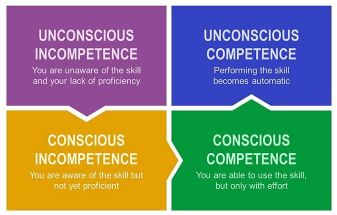Walking is easy, isn't it?
Of course, walking is easy, we learn it once, and we can do it correctly for life. Well, that is the end of that blog!
Not really…
When we are learning to walk, we are tiny, and it is a natural stage in the development of our movement patterns such as rolling, crawling, squatting and hip hinging.
As such, we don't so much learn to walk as explore our surroundings from rolling on the floor to crawling to pulling ourselves; we find mobility, stability and balance and, through falling and picking ourselves back up again, strength.
I was going to liken learning to walk to learning to drive using the four stages of competence.
 It dawned on me that when we are an infant we are not taught how to walk, that is not to say there is not a whole heap of encouragement from eager parents, but it is going to happen regardless, it's innate, built-in, its part of our natural development. Learning to drive is not; learning to drive is a choice. It is something that we must learn. Driving is not a natural process, and by the time we are 16, our minds have built up thoughts and feelings.
It dawned on me that when we are an infant we are not taught how to walk, that is not to say there is not a whole heap of encouragement from eager parents, but it is going to happen regardless, it's innate, built-in, its part of our natural development. Learning to drive is not; learning to drive is a choice. It is something that we must learn. Driving is not a natural process, and by the time we are 16, our minds have built up thoughts and feelings.
Learning to drive is about gaining competence; learning to walk is about human survival.
Why then do we take it for granted?
Walking gets us about, as does the car, and when was the last time you thought about either with anything other than a passing thought. How many times have you arrived at your destination, maybe a regular one, and not remembered chunks of the journey? I know I have.
How do you think you would get on if you had to retake your driving test? (specifically, if you are older than 30!)
How well do you think you would get on if you had to take a walking test? Ok, I know they do not exist, but I would suggest that your walk is not as smooth as you may think it is. I know that because when I work with clients who run or have ankle, knee, hip or back pain, their walk is not great at all.
Take it slowly.
Try this now (if you want!). Stand up, find a little space and walk from one side to the other.
How did that feel? Probably ok, I would imagine, usual.
Now slow it down. Rather than thinking about the list of jobs to be done, think about your walk.
How did that feel? Maybe a little strange. Did certain things feel a bit odd?
Now slow it down more. In this instance, focus on these things:
- Where is your head, position-wise, not in thought?
- When you lift your foot to take a step, what happens to your body weight? Does it shift smoothly onto the other foot? Do you lose a little balance?
- As you move the foot through, do you lean forward or backwards?
- How are your arms moving? Were you evening thinking about your arms in all this!
- When your foot lands, do you put your heel down first, the middle or front of your foot?
- As you push off the now back foot, are you rolling on the outside or inside of your foot?
What's the point?
The point is this. Walking is an intricate movement pattern, and it is one that we adapt continuously to because, and this is the important part, our lives require us to keep moving, and the brain will help make sure that we can keep happening. It will, therefore, remap around the slight twinge in the back, the ache in the knee, the lack of ankle mobility.
The brain will rebalance and recruit different muscles to keep you moving, and the point of that is that it will do this irrespective of creating problems elsewhere; those will be addressed if/when they arise.
Want to start exercising or running?
My recommendation would be to start thinking about how well you walk when you slow it down. Then think about your movement lifestyle, then think about the injuries you may have collected over the years. Then think about how they will translate into a quick, repetitive process with high impact regularly and how much work you will be asking your brain to do to keep you moving at all, let alone safely!
The upside is this if you get your walk right and speed it up, and it's an excellent fat burner, and ultimately you'll get running and stay running without injury.
Moving well isn't just about moving frequently. It's about understanding how you move and then improving the dysfunctional and asymmetrical patterns to rebalance and remap the movement system to a point where it feels like you did when you were a baby.
Take care,
Andrew